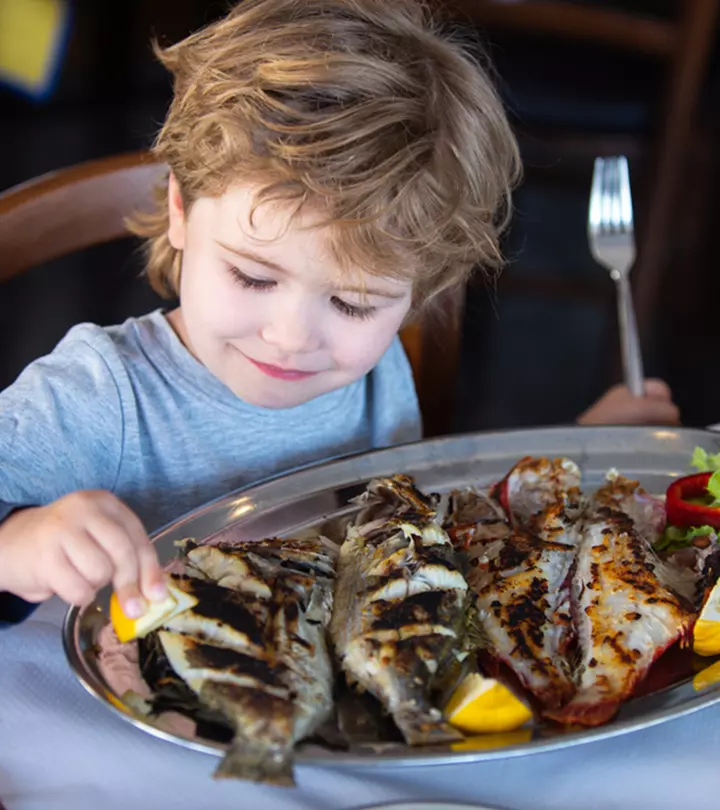
Image: Shutterstock
As your little one explores new tastes, you may wonder if seafood is a good and safe addition to their diet. It’s both delicious and packed with essential nutrients like omega-3 fatty acids and protein. In this article, we’ll explore all about introducing seafood to your child’s diet, its benefits, quantities, and safe preparation. Read on to begin this culinary journey together!
The Benefits Of Seafood In A Baby’s Diet
Image: Shutterstock
Seafood is a nutritional powerhouse, brimming with an array of essential nutrients that are vital for your baby’s overall health and development. Let’s delve deeper into the goodness of seafood and how each nutrient benefits your little one:
1. Omega-3 Fatty Acids: The Brain And Eye Boosters
Seafood, like salmon and sardines, is rich in omega-3 fatty acids (DHA and EPA), vital for your baby’s brain and eye development. DHA supports cognitive functions and visual acuity, laying the foundation for a healthy and sharp mind (1).
2. Protein: The Building Blocks Of Growth
Protein is the backbone of growth and development in infants. Seafood serves as an excellent source of high-quality protein, essential for building and repairing tissues, muscles, and organs (2). As your baby’s body undergoes rapid changes during the early years, protein becomes even more crucial to support their developmental milestones. Including seafood in their diet ensures a well-rounded intake of amino acids, the fundamental building blocks of proteins.
3. Vitamin D: Strengthening Bones And Beyond
Certain types of seafood, such as salmon and mackerel, are natural sources of vitamin D (3). This sunshine vitamin is essential for the absorption of calcium, promoting bone health and strength. Adequate vitamin D intake is especially crucial during infancy when bones are rapidly growing and developing (4). By introducing seafood into your baby’s diet, you contribute to the foundation of robust bones that will support them as they explore the world around them.
3. Essential Minerals: The Precious Elements For Well-Being
Seafood is not only rich in omega-3 and protein but also abundant in essential minerals. Iron, found in clams and shrimp, prevents anemia and supports red blood cell production (5). Zinc boosts the immune system, defending against infections (6). Iodine, present in various seafood, is crucial for thyroid function and overall growth (7).
How Much Seafood Should You Feed Your Child?
Image: Shutterstock
Although seafood offers health benefits for your baby, it’s important to introduce it gradually and in suitable portions. Most pediatricians suggest starting with small servings of cooked, mashed, or pureed seafood when your baby is around six to eight months old. Begin with mild and easily digestible choices like white fish before progressing to more flavorful varieties. This gentle approach will allow your little one’s taste buds and digestive system to adapt, ensuring a positive and safe seafood experience.
As your baby develops a taste for seafood, gradually increase portion size and variety. Remember, moderation is essential to avoid excessive mercury exposure. Opt for low-mercury fish like cod, haddock, or shrimp, and avoid high-mercury types. Enjoy the benefits of seafood while keeping your little one safe.
How Should You Prepare Seafood For Your Baby?
Image: Shutterstock
When preparing seafood for your baby, safety and hygiene are of utmost importance. Follow these guidelines to ensure that your little one enjoys a delicious and risk-free meal:
1. Choose Fresh, High-Quality Seafood
Always select fresh seafood from reputable sources. Ensure that it is properly stored and has not exceeded its expiration date.
2. Start With Simple Preparations
Introduce seafood gradually, starting with plain and mild flavors. Steam, boil, or poach the seafood to maintain its natural taste and nutrients.
3. Avoid Added Seasonings And Spices
Refrain from adding salt, spices, or sauces to your baby’s seafood dishes. Let them explore the natural flavors without any added enhancements.
4. Monitor Allergic Reactions
As with any new food, be watchful for allergic reactions when introducing seafood. Watch for symptoms like hives, swelling, or difficulty breathing. If you notice any adverse reactions, consult your pediatrician immediately.
5. Check For Bones And Choking Hazards
Thoroughly remove any bones from the seafood before serving it to your baby to prevent choking hazards.
6. Be Mindful Of Texture
Image: Shutterstock
Adjust the texture of the seafood based on your baby’s age and development. As they grow, you can gradually introduce chunkier pieces to encourage chewing and oral motor skills.
Introducing seafood to your baby’s diet can be an exciting and nutritious addition to their culinary journey. With its wealth of essential nutrients and health benefits, seafood can positively impact their growth and development. Remember to start with small, well-cooked portions, gradually increasing variety and portion size as your baby grows older.
Always prioritize safety and hygiene when preparing seafood dishes, ensuring they are free from bones, choking hazards, and allergens. As you explore the world of seafood with your little one, you’ll create a foundation of healthy eating habits that will benefit them throughout their lives. Enjoy this delightful journey of culinary discovery together! Let us know in the comments your experience of feeding your baby seafood!
















